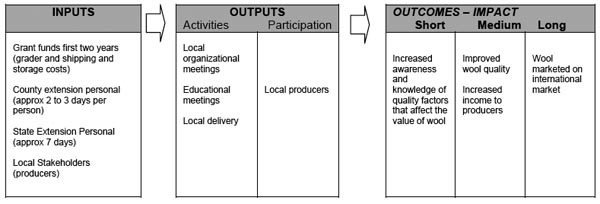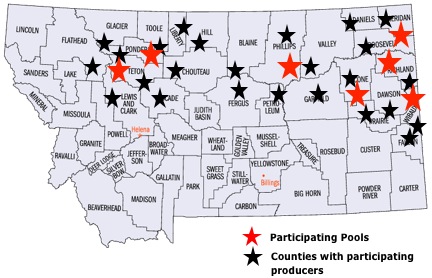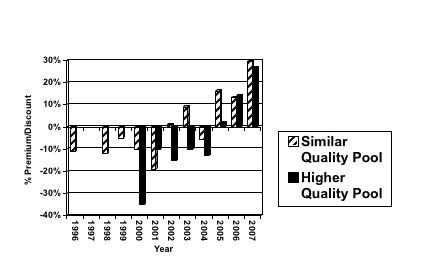 |
February 2009
|
February 2009 // Volume 47 // Number 1 // Ideas at Work // v47-1iw5
Assisting Wool Producers in Accessing an Emerging Global Market
Abstract
A centralized marketing scheme was initiated to assist small sheep producers in adapting to an emerging global market. The goal of the effort was to create an educational environment that facilitated improved wool quality and preparation, which will ultimately lead to increased prices. The ultimate goal was to develop a product that could directly enter the global marketplace. Approximately 150,000 pounds of wool from 140 producers are marketed. Premiums obtained range between 10 and 50 cents per pound depending on quality and can be attributed to both improvements in marketing efficiency and improved quality of wool.
Introduction
One of the most significant challenges facing small producers of agricultural commodities is the efficient marketing of their products. A significant percentage of these growers produce, or have the potential to produce, high-quality product. When these producers are presented with an economic incentive, they will make the effort to properly prepare their smaller volumes to capitalize on the value of their product.
Adapting to the requirements of a global market is particularly a problem for wool producers. Traditionally, wool producers have pooled wool from growers within a defined geographical area. This has been successful in the past because domestic market diversity allowed wool-buying firms to purchase and profitably utilize or remarket the entire offering by each wool pool. Currently, processors are interested in purchasing the types of wool that meet their current and short-term projected needs. Different processors are interested in purchasing only certain types of wool. Marketing wool from producers with small volumes of wool is clearly at a crossroads.
In order to achieve the objective of maximizing wool income for small flock owners, innovative management and marketing strategies must be explored and implemented. The difficulty is that these producers generally do not have sufficient funds or expertise to develop and implement a comprehensive program (Vossen,1992; Renquist, 2007). MSU Extension is assisting growers in adapting to emerging marketing needs through this project.
Program
Program Development
The Eastern Montana Consolidated Wool Pool is a project initiated through a proposal developed by Extension agents from Phillips and Blaine counties. The objective of the project is to develop localized marketing groups and then combine production from these localized entities over a large geographical area, creating large marketable volumes of similar types of product. The development of this program involved the use of a modified logic model planning process (Figure 1) involving state level and county Extension agents as well as local stakeholders. In all cases local stakeholder groups retained the ultimate decision making authority.
Figure 1.
Wool Marketing Logic Model
The key has been developing a system where wool from a large number of growers over a large geographical area can be effectively combined while controlling quality and marketing expenses. Once at the collection point, wool is bag graded into the predefined quality lots. The concept of doing as much wool preparation as possible at the farm is implemented effectively by growers with large numbers of sheep and was the guiding force for developing a system for combining and packaging smaller clips of wool.
Educational Programs
Educational programs associated with this marketing effort are key to the project's success. Educational resources used included the ASI Code of Practice, Wool Quality Improvement videos and brochures, new bulletins on quality, pricing, yield determination, and wool packaging. Each participating grower was provided with a wool grading chart and lot description card developed specifically for this project. An annual newsletter keeps growers informed.
Program Implementation
Initiating change in marketing of the pool wools required the building of trust among wool producers. Financial support obtained from the Montana Sheep Institute, American Sheep Industry Wool Council, and the Montana Department of Agriculture provided the means by which this value added marketing scheme was implemented with no additional cost to the producer. This assistance has been phased out as the program developed and achieved success in returning dollars to the producer (all additional expenses paid in first year and half additional expenses paid in second year). The program is currently self-sustaining. The project has evolved and is currently directed by a producer board made up of members from each local pool.
Results
The Eastern Montana Consolidated Wool Pool project is made of seven local pools including a large portion of Northeastern Montana (400x200 mile rectangle; Figure 2). This project coordinates the delivery and marketing of 150,000 pounds of wool from 140 producers and represents 6 to 7% of the annual wool marketed in Montana (NASS, 2007).
Figure 2.
Eastern Montana Consolidated Wool Pool project
One third of the participating growers delivered less than 500 pounds of wool. In addition, one third of growers market wool in different quality lines.
Based on quality, wool is sorted into four white face lines, two black face lines, and a belly line. All lines except bellies are core tested to determine micron diameter, yield, vegetable contamination, length, and strength. Implementation of the program cost 6.93 cents per pound.
Figure 3 presents a comparison of prices received for a similar and higher quality Montana pool prior to (before 2002) and after the formation of the consolidated effort. Premiums obtained by participating growers range between 10 and 50 cents per pound grease price depending on quality (medium-term outcome). Increases observed in 2006 and 2007 are attributed to both improvements in marketing efficiency and improved quality of wool. Growers are motivated to invest in improving quality when differences in quality are reflected in price differences at the marketplace. In 2007, the best quality line of wool was marketed and shipped directly to China (long-term outcome).
Figure 3.
Comparison of Prices Received to a Similar and Higher Quality Montana Pool Prior to and After Formation of the Consolidated Projectabc
a Prices used for comparison prior to the formation of the consolidated effort (2002) was an average of prices received by the individual pools that comprised the consolidated effort
b Bars below the 0 axes indicated that prices received were below comparative pools while those above indicate prices were above comparative pools.
c Premiums/discounts observed in marketing years 2004 and 2007 was partially an influence of date of sale. However, especially in 2007, market timing cannot account for all the premium.
In addition to facilitating the marketing of producers' wool, the opportunity for Extension was more extensive. County Extension personnel have developed contacts with a large group of their clientele and conduct numerous educational efforts with a greater chance of implementation.
References
NASS. (2007). Montana reports and statistics. Quick Stats. USDA. National Agricultural Statistics Service. Retrieved January 10, 2008 from: http://www.nass.usda.gov/Statistics_by_State/Montana/index.asp
Renquist, S. B. (2007). Creative marketing for a small wine grape region. Journal of Extension [On-line], 45(6) Article 6IAW4. Available at: http://www.joe.org/joe/2007december/iw4.shtml
Vossen, P. (1992). Starting a county agricultural marketing program. Journal of Extension [On-line], 30(3). Available at: http://www.joe.org/joe/1992fall/a8.html




